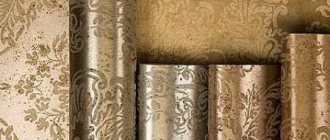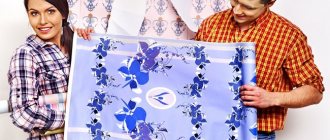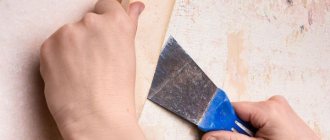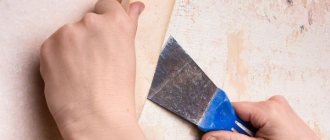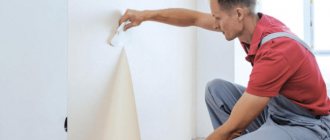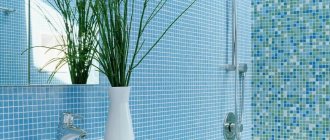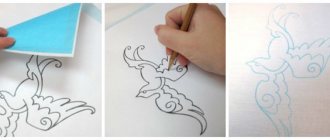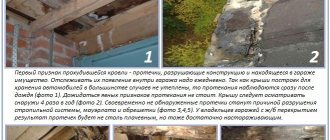The use of washable wallpaper for renovation has long been a trend. This material is easy to stick to the wall and can be used in apartments with children and pets, since the top layer is difficult to damage. In addition, thanks to the moisture-resistant coating, they can be washed even with the use of detergents. But even their service life sooner or later comes to an end. Many non-specialists are faced with the problem of how to remove washable wallpaper.
It is customary to distinguish 4 methods for removing washable wallpaper. Depending on the material of the wallpaper, as well as the surface on which it is pasted, a specialist will choose the best option to easily remove washable wallpaper.
Why remove old coverings from walls?
Some people do not clean the walls of outdated materials - they glue new wallpaper on top of the old ones. Many people do it the old fashioned way. But washable and old Soviet wallpaper are two different materials. Gross mistakes and careless attitude lead to unpleasant consequences. Here are the main ones:
- Dilapidated coatings will soften under the influence of the adhesive and fall off. The result is visible to the naked eye: bulges and blisters form on the wall with the new coating. The decorative canvas looks like sloppy plaster.
- Small folds and air bubbles appear between these two layers. They spoil the appearance of the wall and are difficult to get rid of. Over time, mold and black spots will appear in places with defects (read about why spots appear on wallpaper and how to get rid of them here). The person will have to make new repairs.
- Various uncleaned contaminants and grease gradually affect the new canvas. The result is that after about three weeks the first blurry yellow spots appear.
Attention
attention! Thirty to forty years ago, trellises were only made of paper. They did not interfere with pasting the walls with new wallpaper, did not spoil the entire look, and were well preserved until the next renovation. The production of washable wallpaper differs significantly. Therefore, manufacturers recommend following the instructions on the packaging. Before using modern decorative coatings, you need to carefully prepare the base.
Wallpaper removal tools
Wet wallpaper is the easiest to remove.
Removing old wet wallpaper will not require much effort, certain skills and time if you are thoroughly prepared for this work. To do this, you need to ensure that the following tools are available at the work site:
- metal scraper;
- painting knife;
- steel spatula;
- ladder;
- roller with long pile;
- wallpaper remover.
Depending on the material that forms the basis of wet wallpaper, they can be paper, vinyl or non-woven.
How to remove material
The following instructions will help you quickly remove washable material from the wall.
- Thoroughly moisten the surface with water from a bottle with a spray nozzle or sponge.
- Wait 15-20 minutes. If it is difficult to remove, then the procedure with water must be repeated several times. You can use a special composition that quickly softens the base.
- Separate the material from the wall along the width from the seam side. Then remove the residue evenly.
- If the surface has had time to dry, then wet it slightly. The main thing is that the water does not drain, but is absorbed. You should be careful with drywall: it does not like moisture, under its influence it becomes deformed and falls off.
- Use the scraper with extreme caution. Otherwise, the plaster will be damaged and additional repairs will be required.
- Pay special attention to pieces of material located near sockets and electrical switches. Leaving areas untouched increases the risk of damage to the new finish.
Important
Attention! It is strictly forbidden to wet the old coating near non-de-energized sockets or switches. Otherwise, you can cause significant harm to your health.
Wet method
The most common method is cleaning with water. For this you will need a water sprayer that can be screwed onto a regular PVC bottle, as well as a spatula. If your room has loose, washable wallpaper, especially paper-based wallpaper, this method will be the least expensive both in terms of the cost of materials and physical effort.
Fill up with water and wet the surface generously with a spray bottle. Considering that you need to remove old washable wallpaper, you can wet the walls with a regular wet sponge. After the water has been absorbed into the top layer, use a spatula to carefully lift the wallpaper along its entire length. Gradually tear off the trellises further, if necessary adding water at the point where the bottom layer comes into contact with the wall.
Be careful, as when gluing the sheets directly onto the plaster, you can accidentally remove the washable coatings from the wall along with the plaster, which will lead to subsequent additional repairs.
Perhaps this is also the most effective way. It is suitable for almost all types of washable wallpaper, including liquid wallpaper.
What's the easiest way to remove it?
The removal method depends on the class of washable wallpaper. The general material and base of the finishing coating affect the complexity of the process.
- Washable with moisture-resistant coating. Decorative finishing copes well with the assigned tasks: moisture does not get between the wall and the trellises, condensation, dust, fungus, and mold do not accumulate. It is difficult to remove this layer, but proper preliminary preparation will give results. It is recommended to treat the canvas with a special compound. Then remove them and sand the wall with sandpaper or a grinding stone.
- Liquid, washable glass wallpaper. Liquid wallpaper is easily removed after softening with water, but with the second category you will have to suffer. Use only special formulations that allow you to get rid of the old in a few hours. Some people who are new to the job are advised to call a professional who knows how to remove fiberglass materials.
- Double layer. Dismantling is carried out layer by layer: first the top, then the bottom. Here are some recommendations:
- the top layer can be removed using technology for moisture-resistant trellises;
- Moisten the bottom layer thoroughly; it will easily come off;
- if the base is made of fabric, then after dismantling it, treat the wall surface with a grinding wheel or any other tool.
Attention
Attention! Protect your eyes and respiratory tract when using sanding tools.
Vinyl washable coatings easily fall off the base after they are wetted with special solutions according to the instructions. Apply only with a roller, wearing gloves. If the solution gets on your hands, you should immediately wash them with laundry soap. Read about how to easily and quickly remove vinyl wallpaper from walls.
How to fuck in the kitchen?
Folk recipes versus modern technologies are an ineffective method of struggle.
Soap solutions or starch-based mixtures will not soften the adhesive base of the trellises. Grandmother's recipes have long been replaced by miracle drugs. They help save time and effort. All types of compositions come in 3 groups:
- Solutions based on acids or solvents (gasoline, acetone, turpentine). It is better not to buy them because of the dangerous evaporating vapors and the inability to moisturize the base.
- Alkalis - instantly penetrate into the structure of the canvas. After 10-15 minutes it will come off easily.
- Compositions with neutral pH and nonionic surfactants. They quickly soften the glue, destroying even a strong base.
Manufacturers offer many solutions: Methylane, Dissoucol, Axton, Tapex, Cleo Antiwall. They do an excellent job with their tasks and have only positive reviews.
Attention
Attention! Before using the drug, it is necessary to prepare the room. Remove furniture and cover the floor with plastic film. Use personal protective equipment - goggles, mask or respirator. After completing all work, ventilate the kitchen for several hours.
Read more about waterproof wallpaper
So, what can we say about washable wallpaper? They are the embodiment of what many housewives have dreamed of for so long: thanks to this coating, the walls can not only be cleaned, but also washed using a light soap solution, which, in fact, is not only very practical, but also helps to save the family budget, thanks to the rarer carrying out repairs.
What provides such unique characteristics? In fact, everything is quite simple. The reason lies in the multilayer design of such products. Moreover, each layer is “responsible for its part of the work.” So what do they provide:
- The basis of such wallpaper is usually made on a non-woven base. Less often it can be paper.
- As for the decorative coating, which is located outside, the material for its production, in most cases, is vinyl. It is used due to its excellent steam-conducting characteristics.
Be aware: sometimes you can find waterproof glass wallpaper on sale. A distinctive feature of this coating is that they can be painted. Moreover, this procedure can be carried out several times.
Quite curious is the fact that such a coating, despite some prejudices, is extremely safe for health and clean from an environmental point of view. Well, now let’s take a closer look at some of the inherent features of this wallpaper.
Features to Consider
Washable wallpaper has a number of advantages. However, in order to avoid some shortcomings from appearing, you must strictly follow all the instructions both when gluing them and in those cases when you need to remove them from the wall. So, here are some tips and tricks to consider when working with them:
- When gluing, try to glue such wallpaper end-to-end. The fact is that if you glue thick sheets of overlap, this will result in the appearance of noticeable and very ugly seams. If you glue adjacent sheets end-to-end, the seam will become almost invisible, even at close range.
- In cases where the preparation of the walls was not done in the best possible way, it is advisable to use wallpaper as thick as possible. An example of a decorative coating is foamed vinyl. It is this layer that can mask some mechanical damage present on the surface of the walls. However, be careful: deep enough cracks, chips and scratches cannot be hidden.
- If you decide to use wallpaper with silk-screen printing, then you need to be very careful in preparing the walls for gluing, since this material is quite thin, and otherwise all minor damage to the working surface will become noticeable.
- When gluing, when you smooth out washable wallpaper (as well as most others), you need to use a special plastic comb. The wallpaper should be ironed from the middle to the edges and from top to bottom.
- As for performing the work, it is advisable to carry it out not independently, doing everything exclusively with your own hands, but to involve a garbage dump. Together, you will make all the repairs much faster, and the number of damaged wallpaper will be reduced to zero.
- By the way, to prevent the wallpaper from stretching, you can apply a layer of glue only to the wall. This is a distinctive feature of non-woven fabric and its next advantage over a number of analogues.
Attention! It is necessary to take a very responsible approach to the choice of adhesive composition for washable wallpaper. When purchasing a package of glue, pay attention to the markings and instructions, in which the manufacturer provides all the necessary information.
Tips from the experts
There are times when there are no special “magic” liquids in the house, and the materials are already ready for removal. Interesting methods will help here:
- Previously glued canvases with PVA glue can be easily removed with a solution prepared from water and dishwashing detergent. There should be a lot of the last ingredient: for example, in 1 liter of water it is enough to stir 3 tbsp. spoons of washing liquid.
- Clean plasterboard walls carefully. This building material, as practice shows, is easily deformed under the influence of water and spatulas. Wallpaper must be wetted and removed gradually: first one canvas, then another.
- The grinder can be replaced with an interesting device - an electric drill with a stiff wire brush attached to it.
- Old glue will soften under the influence of a regular steam iron. But perform manipulations through foil or a damp cloth.
- After treating the surface with hard or abrasive tools, check it for chips and scratches. If damage is noticed, level it with primer or cement mortar.
- To avoid the appearance of yellow spots on freshly glued strips, it is recommended to check the acid-base balance of the surface layer of the wall before applying again. Litmus paper will help you complete the process: if it changes color, then the wall needs to be treated. The deep-penetrating primer Glutogrund LF has proven itself well.
- Vinyls are separated into solid sheets under the influence of a steam generator. The material can be reused for decoration or decoration.
Usually people use 4 methods of removing coatings in practice, without involving craftsmen. Each method has features and disadvantages:
- Removal with bare hands. Use a spatula or knife. The tool is used to pick up the upper or lower edge of the canvas. The material may easily fall off or break into pieces. In the latter case, the surface is thoroughly cleaned and sanded.
Pros - safety for health.Disadvantages - waste of a huge amount of time with an unfavorable outcome. You can spend a whole day removing decorative coating from one wall.
- Water procedures. Use only hot water, applied with a spray bottle or dish sponge.
Pros: savings, safety for humans.Disadvantages - unnecessary waste of time. You need to wait about 20-30 minutes for the glue to completely soften.
- Steam method. This method has some disadvantages if you don’t have a steam generator at hand. To imagine that you have to stand for 20 minutes with an iron in your hands to steam each strip will only spoil your mood.
- Liquids. The most effective method of all existing ones. A person gets rid of old coating in minutes. But chemistry can be hazardous to health. Therefore, personal protective equipment is needed.
Advice
Advice. If you still have the label from the previous decorative coatings, you can read the manufacturer’s recommendations. It shows how to glue washable materials and how to remove them. To have such a fragment is real luck. You don’t have to go through folk tips and methods to remove old canvases.
Before removing washable wallpaper, you need to prepare, protect your eyes and respiratory tract. Remove all interior items and protect the flooring. Remove decorative material carefully, especially from drywall. Take care to remove surface damage and use only proven products.
Steam method
This method also involves the use of water. But here it is combined with steam and high temperature. It is used if the trellises have a dense top layer. At the very beginning, we recommend making several cuts over the entire surface area for better steam penetration into the structure of the material. To perform this operation, you can use a scraper, spatula or utility knife.
Both a special steam generator, a household steamer, and a regular iron with a steam function are suitable. Slowly work over the entire surface of the wallpaper. Hot steam in combination with water will destroy the adhesive base and soften the structure of the wallpaper.
Most likely, with proper processing, a spatula will only be needed for the initial peeling of the edge of the wallpaper from the wall. Now just pull the canvas away from the wall.
Removing double-layer wallpaper
Create holes for water to pass through.
If it is necessary to dismantle wallpaper consisting of two layers, they must be removed layer by layer. First, the top layer is removed, and then the bottom layer.
- the top layer is removed using the technology described for moisture-resistant surfaces, with preliminary disturbance of the surface to allow water penetration;
- the bottom paper-based layer is also removed after pre-wetting the surface;
- When dismantling the fabric base, in addition to the measures listed above, it may be necessary to use a grinding wheel or other mechanical action.
To remove vinyl wallpaper, you can use specialized solutions. Before using them, you must read the instructions. They are applied to the wall using a roller. After absorption with a spatula, the finishing material is removed.
How to carefully and effectively remove wallpaper from walls and ceilings, bamboo wallpaper intact, without damaging it?
If you don’t want to tear expensive bamboo wallpaper, then the only way to remove it without damaging it is steaming. Use a steamer or iron the surface with a damp cloth.
How to carefully and effectively remove wallpaper from walls and ceilings, bamboo wallpaper intact, without damaging it?
Removing old wallpaper using a special liquid
Suitable for those who don’t want to waste their time on the water method. There are special products that are also applied to the wall. They are inexpensive, and their effect is faster. Just don't expect a miracle. You definitely won't be able to do it in 3 minutes. This method is not much faster than the previous one.
Operating procedure:
- The purchased product is prepared for application to the wall, following the instructions on the package.
- Apply to the wall and leave for about 3 hours (everything is written in the instructions).
- After this, simply and easily remove the old coating.
It sounds nice, but in reality there are nuances. This product is not always applied in the required quantity. In this regard, after removing the wallpaper using this product, they return to the method with soapy water.
This method is suitable for all modern types of wallpaper.
Removing old wallpaper glued with PVA glue
PVA does not dissolve in water. Therefore, there are difficulties in removing such a coating. Add soap or vinegar to the water and the removal process will be easier.
A sander and spatula are also used. This is a guaranteed method. Using a spatula, find elements that will remove themselves. Everything else is removed by sanding.
Wallpaper care
Although wallpaper is called washable, you should not water it with water and cleaning products every day. It is better to wipe the surface of the coating with a damp sponge or cloth. If you really cannot do without chemicals, limit yourself to a weak soap solution. With the advent of modern technology, some people prefer to use a washing vacuum cleaner. This is absolutely not allowed! Wet cleaning can leave stains and smudges, and a brush can damage the structure of the wallpaper.
Before you start cleaning, try wiping a small section of the wall to make sure the wallpaper is intact and intact. Study bathtubs made of cast marble at the link.
Pictured is wallpaper in the bathroom
